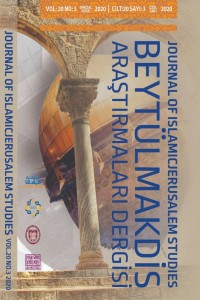Araştırma Makalesi
Yıl 2020,
Cilt: 20 Sayı: 3, 337 - 351, 31.12.2020
Öz
1091’de vefat eden Kudüs Valisi Artuk Bey’in ardından çocukları Sökmen ve İlgazi, Fatımî saldırısı üzerine Kudüs’ten ayrıldılar. Eminüddin Sökmen 1101’de Hasankeyf, Meyyafarikin (Silvan) ve Diyarbakır’ı ele geçirip Artuklu Beyliği’nin ilk kolunu kurdu. Necmeddin İlgazi 1108’de Mardin’i ele geçirip, Beyliğin merkezi yaptı. Halep ve Harput’un katılmasıyla, 307 yıl sürecek Beylik kuruldu. İlgazi ve yeğeni Belek Gazi, Haçlılara karşı yaptıkları savaşlarla ünlendiler. Fethedilen topraklara yerleşme, Haçlılara karşı verilen savaşlar göz açtırmazken; Artuklular 1123 yılında Eminüddin Külliyesi’ni açarak, Türkiye Tarihi’nde bir ilki gerçekleştirdi. Külliye; mescid, medrese, bimaristan, zâviye, yazlık namazgâh, hamam, çeşme ve selsebîlden oluşuyordu. Artuklu Beyliği’nin kurucusu Eminüddin Sökmen tarafından inşaatı başlatıldı, vefatından sonra kardeşi Necmeddin İlgazi tarafından tamamlandı. Bimâristan (Darüşşifa-Hastahane) olarak kullanıldığı dönemde, büyük ün kazandı. Bimaristanda, İslâm Dünyasındakilerden farklı yöntemler kullanıldı. Mimarîde üstü açık avlular ve hamam bölümlerinde uygulamalı bilgiler verilen bir tıp medresesi ve şifahane olarak tasarlanırken, tedavide bitkisel ilaçlar, şifalı açık hava ve su tedavisi kullanıldı. XIX. asra kadar bu görevini sürdürdüğü belgelerden anlaşılmaktadır. Kurulduğu andan itibaren, tedavi usûlleri ve çalışanlarıyla ünlenen Bimaristana, başta Musul olmak üzere diğer illerden gelen hastalar ve Haçlı Savaşları’nda yaralananlar önemli bir yoğunluk oluşturarak, şehrin ekonomisine katkıda bulundu.
Anahtar Kelimeler
Kaynakça
- MAALESEF KAYNAKÇAYI EKLEMEKTE TEKNİK SORUN YAŞADIM. MAKALENİN ANA METNİNİN SONUNDA YER ALIYOR. ORADAN ALINABİLİRSE ÇOK İYİ OLUR.
Yıl 2020,
Cilt: 20 Sayı: 3, 337 - 351, 31.12.2020
Öz
بعد وفاة حاكم بيت المقدس أرتق بيك عام 1091، غادر ولديه سقمان وإيلغازي بيت المقدس بعد الهجوم الفاطمي على المدينة المقدسة. استولى أمين الدين سقمان على حصن كيفا، وميافارقين (سلوان)، وآمد (ديار بكر) في عام 1101 وأنشأ أول فرع لإمارة الأراتقة. استولى نجم الدين ايلغازي على ماردين عام 1108 وجعلها مركز الإمارة. بمشاركة حلب وخربوت، تم إنشاء دولتهم التي امتدت لمدة 307 سنوات. اشتهر إيلغازي وابن أخيه بلك غازي بحروبهما ضد الصليبيين. بينما كانت الحروب ضد الصليبيين مستعرة لم يتوقفوا عن تطوير بلادهم. حيث اففتح في العام 1123م كلية أمين الدين، وهي الأولى في تاريخ الاتراك؛ حيث كان تتألف من مسجد، مدرسة، بيمارستان، نزل، مصلى للصيف، حمام، نافورة وسلسبيل. وقد بدأ تشييده من قبل أمين الدين سقمان، مؤسس الدولة الأرتقية، واكتمل بناءه على يدي شقيقه نجم الدين إيلغازي بعد وفاته. اكتسب هذا الصرح سمعة كبيرة عندما تم استخدامه كبيماريستان (مستشفى/ دار الشفاء). تم استخدام تصميم الساحات المفتوحة وأقسام الحمامات في العمارة كمدرسة طبية ومستشفى حيث تم تقديم المعلومات التطبيقية للطب، كما وتم استخدام الأدوية العشبية والعلاج في الهواء الطلق والعلاج بالماء في أساليب التداوي. وتظهر الوثائق أنه بقي يستخدم كمشفى إلى القرن التاسع عشر في الفترة العثمانية. ساهم البيمارستان في اقتصاد المدينة من خلال ايجاد كثافة كبيرة من المرضى القادمين من المحافظات الأخرى، وخاصة الموصل للعلاج، بالاضافة لمعالجة المصابين في الحروب الصليبية.
Anahtar Kelimeler
Kaynakça
- MAALESEF KAYNAKÇAYI EKLEMEKTE TEKNİK SORUN YAŞADIM. MAKALENİN ANA METNİNİN SONUNDA YER ALIYOR. ORADAN ALINABİLİRSE ÇOK İYİ OLUR.
Yıl 2020,
Cilt: 20 Sayı: 3, 337 - 351, 31.12.2020
Öz
After the death of the governor of Jerusalem, Artuk Bey, in 1091, and following the Fatimid attack on the holy city, his children Sokman and Ilgazi left Bayt al-Maqdis. Sokman captured Hasankeyf, Mayyafariqin (Silvan) and Amid (Diyarbakır) in 1101 and established the first Artuqid Principality. Najm al-Din Ilghazi conquered Mardin in 1108 and declared it the capital of the Principality. With the conquest of Aleppo and Harput, the principality that would last 307 years was established. Ilghazi and his nephew Belek Ghazi became famous for fighting against the Crusaders. While they were busy settling in the conquered lands and fighting the Crusaders, the Artuqids founded in 1123 the Amin al-Din Complex, the first in Turkish history. The complex included a mosque, a madrasah, a hospital, lodges, a summer prayer space, a bath, a fountain and a special water well. Its construction was initiated by Amin al-Din Sokman, the founder of the Artuqid Principality, and was completed after his death by his brother Najm al-Din Ilghazi. It became famous during the period when it was used as a hospital. Different methods were employed in the hospital than those adopted in the Muslim World. While it was designed as a medical school/ madrasah and hospital where applied knowledge was instructed in its open courtyards, the bath section architecture, herbal medicine, the outdoors and water therapies were also used as treatments. It was used as a hospital until the 19th century based on archival documents from the time. The hospital, which was famous for its treatment methods and staff since its establishment, has contributed to the urban economy by attracting significant numbers of patients from other provinces, especially Mosul, and those injured in the Crusades.
Anahtar Kelimeler
Kaynakça
- MAALESEF KAYNAKÇAYI EKLEMEKTE TEKNİK SORUN YAŞADIM. MAKALENİN ANA METNİNİN SONUNDA YER ALIYOR. ORADAN ALINABİLİRSE ÇOK İYİ OLUR.
Toplam 1 adet kaynakça vardır.
Ayrıntılar
| Birincil Dil | Türkçe |
|---|---|
| Bölüm | Makaleler |
| Yazarlar | |
| Yayımlanma Tarihi | 31 Aralık 2020 |
| Yayımlandığı Sayı | Yıl 2020 Cilt: 20 Sayı: 3 |






